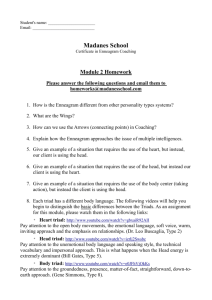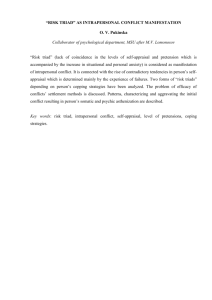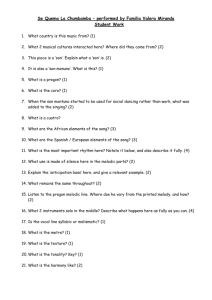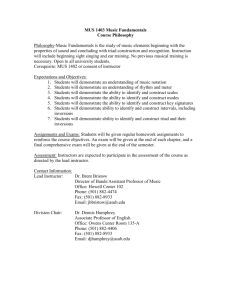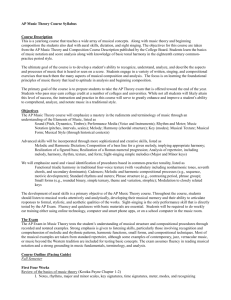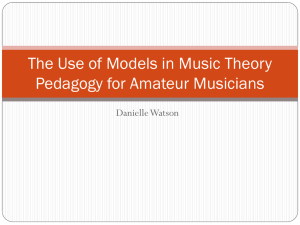Harmony and Theory I
advertisement
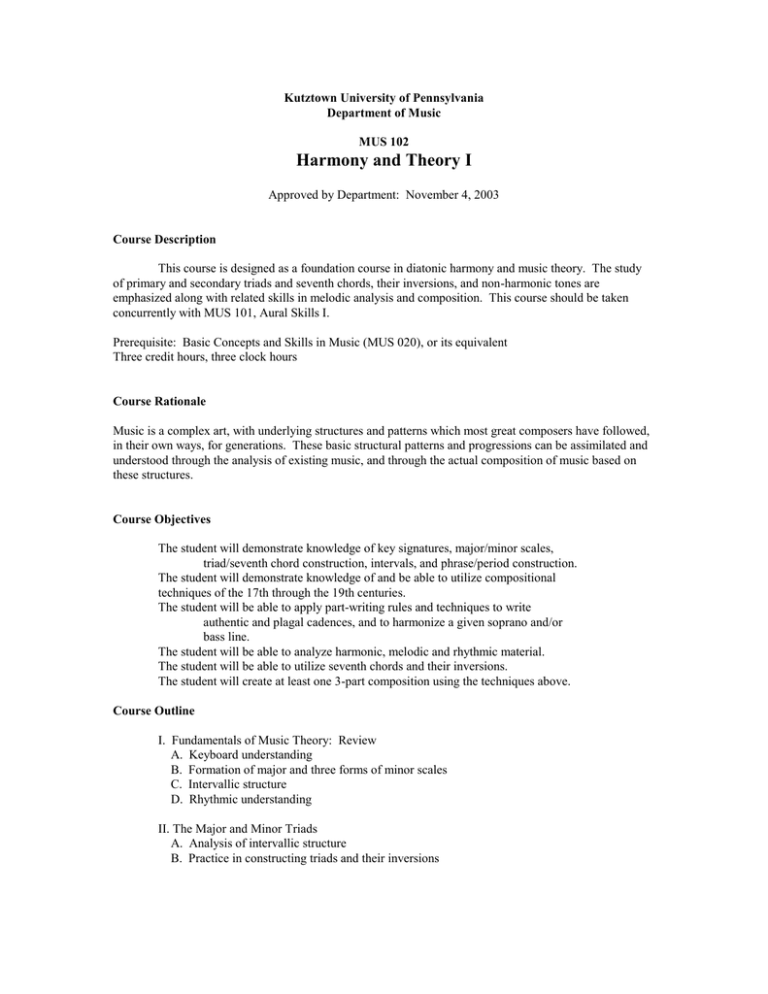
Kutztown University of Pennsylvania Department of Music MUS 102 Harmony and Theory I Approved by Department: November 4, 2003 Course Description This course is designed as a foundation course in diatonic harmony and music theory. The study of primary and secondary triads and seventh chords, their inversions, and non-harmonic tones are emphasized along with related skills in melodic analysis and composition. This course should be taken concurrently with MUS 101, Aural Skills I. Prerequisite: Basic Concepts and Skills in Music (MUS 020), or its equivalent Three credit hours, three clock hours Course Rationale Music is a complex art, with underlying structures and patterns which most great composers have followed, in their own ways, for generations. These basic structural patterns and progressions can be assimilated and understood through the analysis of existing music, and through the actual composition of music based on these structures. Course Objectives The student will demonstrate knowledge of key signatures, major/minor scales, triad/seventh chord construction, intervals, and phrase/period construction. The student will demonstrate knowledge of and be able to utilize compositional techniques of the 17th through the 19th centuries. The student will be able to apply part-writing rules and techniques to write authentic and plagal cadences, and to harmonize a given soprano and/or bass line. The student will be able to analyze harmonic, melodic and rhythmic material. The student will be able to utilize seventh chords and their inversions. The student will create at least one 3-part composition using the techniques above. Course Outline I. Fundamentals of Music Theory: Review A. Keyboard understanding B. Formation of major and three forms of minor scales C. Intervallic structure D. Rhythmic understanding II. The Major and Minor Triads A. Analysis of intervallic structure B. Practice in constructing triads and their inversions III. Rhythm: Its Theory and Analysis A. The beat and its subdivisions B. Meter C. Time Signature: simple and compound IV. Tonic and Dominant: the Authentic Cadence A. Cadences using dominant harmony: perfect, imperfect, half B. Cadences using non-harmonic tones and inversions V. Principles of Part-writing A. Range of each voice B. Doubling C. Position: open, close D. Distance between voices VI. Melodic Line: Its Theory and Analysis A. Phrase structure; parallel and contrasting periods B. Melodic analysis: scale-wise patterns, skips, repetition, sequences, nonharmonic tones C. Creative melodic composition VII. The Alto and Tenor Clefs A. Transposition VIII. The Subdominant Triad A. Plagal cadences; IV-I and iv-i progressions B. Melodic use of subdominant triad C. IV-V and iv-V progressions IX. The Triad in Inversion: A. First and second inversion; uses; analysis; part-writing X. Non-harmonic Tones A. Passing tones, neighbor tones B. Suspension and retardation C. Anticipation D. Appogiature E. Escaped tone (echappe) F. Changing tones G. Pedal point XI. Secondary Triads; Figured Bass Symbols A. Principles of harmonic progression B. The diminished triad C. The leading tone triad D. The supertonic triad E. The submediant and mediant triads F. Figured bass Assessment: Assessment of each student’s level of accomplishment with reference to the course objectives will be based upon the following: A. Regular assignments in analysis, part-writing, and guided composition B. Creative projects in composition, with in-class performances of student works C. Examinations and quizzes Instructional Resources: Benward, Bruce. Music in Theory and Practice, sixth edition. Dubuque, Iowa: William C. Brown Publishers, 1997. Dorr, Joyce. Introductory Music Theory. Belmont, CA: Wadsworth Publishing Co., 1995. Duckworth, William. A Creative Approach to Music Fundamentals. Belmont, CA: Wadsworth Publishing Co., 1995. Gauldin, Robert. Harmonic Practice in Tonal Music. New York: W.W. Norton and Company, Inc., 1997. Henry, Earl. Fundamentals of Music, second edition. Englewood Cliffs, NJ: Prentice Hall, 1993. Herrold, Rebecca M. Mastering the Fundamentals of Music. Upper Saddle River, NJ: Prentice Hall, 1997. Kostak, Stefan and Dorothy Payne. Tonal Harmony, fifth edition. Boston: McGraw-Hill, 2004. Levy, Ernst. A Theory of Harmony. Albany, NY: Sate University of New York Press, 1985. Manoff, Tom. The Music Kit, third edition. New York: W.W. Norton, 1994. Ottman, Robert W. and Frank D. Mainous. Rudiments of Music. Englewood Cliffs, NJ: Prentice Hall, 1995. ________. Elementary Harmony. Upper Saddle River, NJ: Prentice Hall, 2000. Rumery, Kenneth R. Introduction to Musical Design. Dubuque, Iowa: Wm. C. Brown, 1992. Piston, Walter. Harmony, fifth edition. New York: W. W. Norton, 1987. Spencer, Peter. The Practice of Harmony, third edition. Upper Saddle River, NJ: Prentice-Hall, Inc., 1996. Turek, Ralph: The Elements of Music, second edition. New York: McGraw-Hill, 1996.

